So, I begin this final post on Charles Knight’s diaries with a book mentioned in an earlier diary that Hazel just found – In Diary 6, November 7, 1833, Charles writes:
‘read to Henry the Memoirs of Dalrymple’.
Memoirs of Great Britain and Ireland. From the Dissolution of the last Parliament of Charles II. Until the Sea-battle off La Hogue. By Sir John Dalrymple, Bart. The second edition. Printed for W. Strahan; and T. Cadell, in the Strand: and A. Kincaid and J. Bell, and J. Balfour, Edinburgh, 1771-88.
This 3 volume set is found in the GPL catalogue and was listed in the 1908 catalogue, but is alas! A LOST SHEEP.
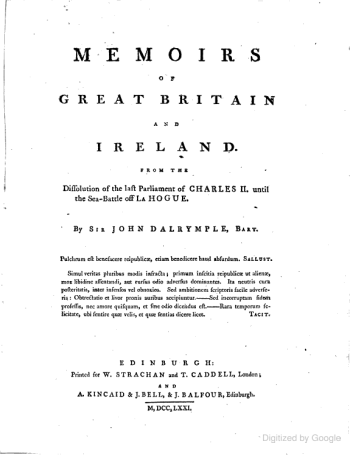 According to Wikipedia, “Sir John Dalrymple of Cousland, 4th Baronet (1726 – 26 February 1810) was a Scottish advocate, judge, chemist and author. He is best known for his Memoirs of Great Britain and Ireland from the dissolution of the last parliament of Charles II until the sea battle of La Hogue, first published in 1771. A new edition of 1790 carried on to the capture of the French and Spanish navies at Vigo. The Dalrymples formed a dynasty among the legal profession in Scotland. Although a central figure in the Scottish Enlightenment and a friend of persons like David Hume and Adam Smith, Dalrymple’s writings were rather unappreciated and he has been described as an irritating member of the Edinburgh literati.” [love this!]
According to Wikipedia, “Sir John Dalrymple of Cousland, 4th Baronet (1726 – 26 February 1810) was a Scottish advocate, judge, chemist and author. He is best known for his Memoirs of Great Britain and Ireland from the dissolution of the last parliament of Charles II until the sea battle of La Hogue, first published in 1771. A new edition of 1790 carried on to the capture of the French and Spanish navies at Vigo. The Dalrymples formed a dynasty among the legal profession in Scotland. Although a central figure in the Scottish Enlightenment and a friend of persons like David Hume and Adam Smith, Dalrymple’s writings were rather unappreciated and he has been described as an irritating member of the Edinburgh literati.” [love this!]
************
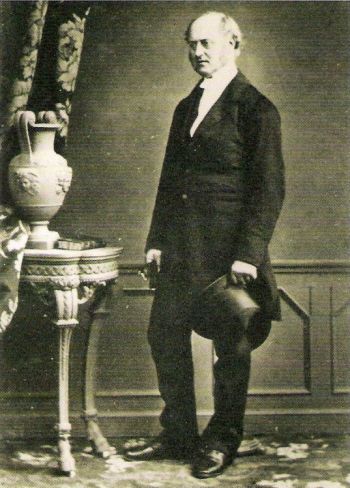
Now on to the last of the Diaries, numbers 13, 14, and 15. These three diaries are dated January 1837 through March 1851. None of the books mentioned will be in the Godmersham Library catalogue, and as Hazel notes:
“Attached are Charles’ diary entries which mention books or reading. They are numbered 13, 14 and 15 on the cover. There is no 12, but it isn’t missing – the dates continue more or less uninterrupted from Diary 11. The final diary ends in March 1851. There must be other diaries out there – I cannot believe that he just stopped. The references to books are few and far between over these years. He belongs to a book club, but fails to specify the texts bought in from Varty’s or his response to them. Neither does he reveal the titles of books read on visits to his parishioners (I think I found one.) Frequent trips back to Godmersham are disappointingly unrecorded, beyond the date he leaves and returns to Chawton.”
Diary marked number 13, January 30th 1837 – September 25th 1837; January 1841 to November 9th 1844:
No evidence of reading, but:
1844: ‘Thursday Feby 8. I spent most of the day with Adela. Willis came about cleaning the pictures.’
‘Friday ... I was with Adela looking over old pictures.’
[Charles is at Chawton, Adela is Edward II’s 2nd wife and mother of Montagu! (who did care very much about the books, even if his father didn’t!)]. I have asked Chawton House is there is any knowledge of a Willis – a servant, either man or woman – a check into local census records of the time mention no one with that name…] – a picture of Adela is forthcoming. Reading Hazel’s newest book – see below – you learn more about Adela. I love this image of she and Charles looking over old pictures…]
***********
Diary marked number 14, November 10th 1844 to July 31st 1847:
1845 ‘Saturday June 28 … Read Eothen.’ [he continues reading Monday June 30th]
Alexander William Kinglake. Eothen; or Traces of travel brought home from the East. London: J Ollivier, 1844.
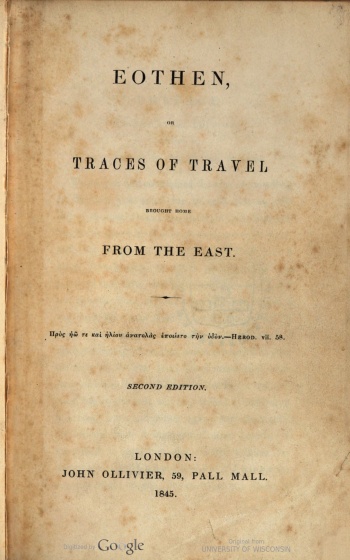
Eothen title page – 2nd edition (all I could find)
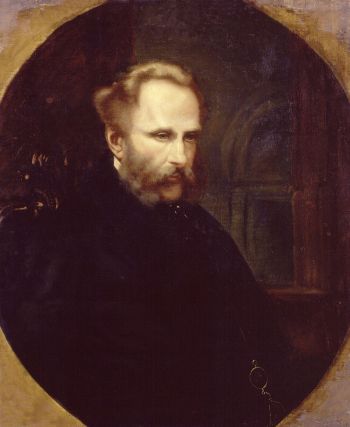
Kinglake – 1863 portrait by Harriet M. Haviland (National Portrait Gallery)
Alexander Kinglake (1809–1891) was an English travel writer and historian. Eothen was originally published anonymously and very popular, and tells of his travels in Syria, Palestine, and Egypt. He is most known for his The Invasion of the Crimea: Its Origin, and an Account of its Progress down to the Death of Lord Raglan, in 8 volumes, published from 1863 to 1887 by Blackwood, Edinburgh. This book is listed in the 1908 catalogue (under Crimea) with an incorrect publication date; and all 8 volumes are still in the Knight Collection, but nothing on Eothen.
You can read a recent edition with an introduction here.
***********
‘Monday August 25 … Dined at Wigrams & met some Heathcotes; and sang. I took an old book full of songs from the Gt House – which was of use.’
So, what this is anybody’s guess! No knowing if they were religious songs or something more light-hearted. There is listed in the Knight Collection a book titled Divine Songs, by Isaac Watts – no mention of this either in the GPL 1818 or Chawton 1908 catalogues, but it was published in 1715 as Divine Songs Attempted in Easy Language for the Use of Children (also known as Divine and Moral Songs for Children, a collection of didactic, moralistic poetry for children that for the next 150 years remained one of the most popular of children’s books and went into many editions. It looks like something that might have been / should have been in the GPL, and something Charles would have been familiar with, and likely used so much it wasn’t on the shelf during the cataloguing process – but I am completely digressing / guessing here!
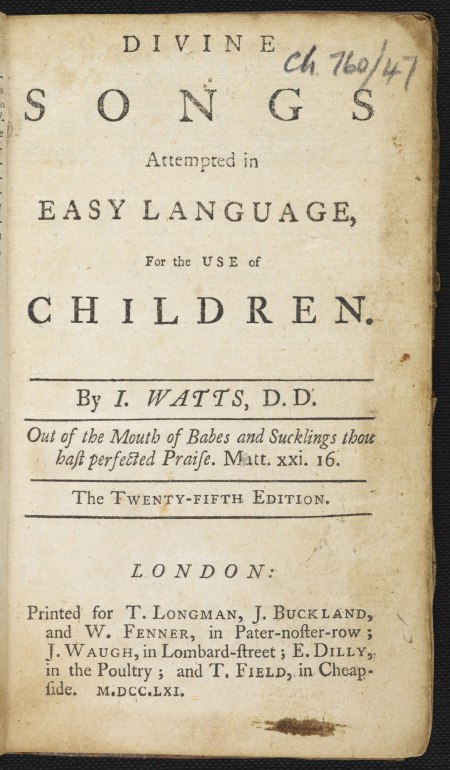
Divine Songs – title page – British Library
**********
‘Wednesday Nov 5. I walked to Alton … Looked in at Mrs Faithfull to leave Sumner’s exposition of the Gospels, which I mean to read there.’
‘Drew a little to make a beginning, copying from a beginner’s book of the childrens (Edward’s children). Read some French grammar.’
We discussed a different book by Sumner in Part III of these Diary posts :
A Series of sermons on the Christian faith and character, by John Bird Sumner. London, 1823. Not in the GPL. But is in 1908 and the Knight Collection.
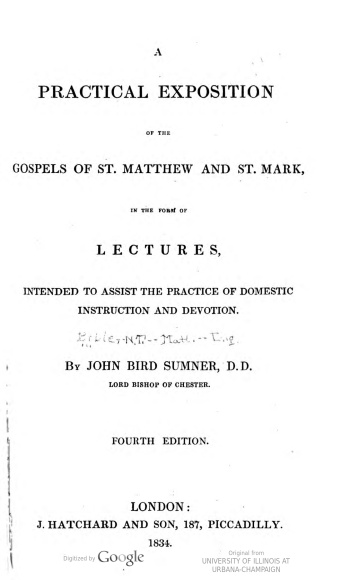
This one now mentioned is A Practical Exposition of the Gospels of St. Matthew and St. Mark, in the form of lectures … By J. B. Sumner. London : J. Hatchard & Son, 1831. The 1834 edition of this is listed in 1908 and remains in the Knight Collection, so likely what Charles is referring to.
John Bird Sumner, 1780-1862, was a bishop in the Church of England and Archbishop of Canterbury from 1848-62. He wrote numerous treatises on religion, and while none are in the GPL catalogue, several are listed in the 1908 and remain in the Knight Collection.
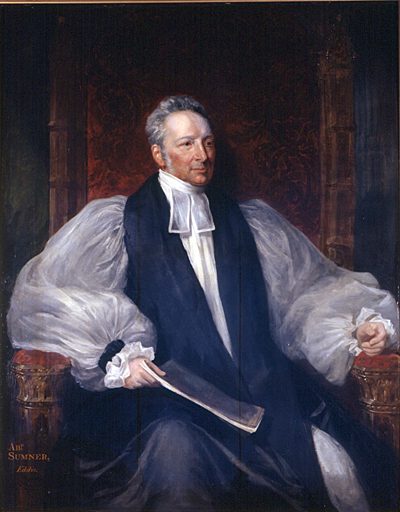 Portrait of Sumner attributed to Eden Upton Eddis – Wikipedia
Portrait of Sumner attributed to Eden Upton Eddis – Wikipedia
Don’t know to what children’s book he is referring, but interesting that he has taken up drawing, and continuing with his French.
***************
‘Tuesday Nov 11 …. Read at Mrs Faithfull’s at half past ten, one of Sumner’s lectures on St Matthew [see above] to her & Sally Howard.’
‘Friday Nov 27 … I wrote to desire Roake & Varty to send Crawley the Bishops charge & Wigram’s sermon.’ (His friend Crawley from his days at Trinity College Cambridge, who now lives in Wales).
See Diaries Part V for information on Roake & Varty, publishers and booksellers that Charles frequently purchased from: https://readingwithaustenblog.com/2020/04/22/reading-in-the-godmersham-library-jane-austens-nephew-charles-bridges-knight-part-v/
Wigram’s Sermon refers to this:
Art. II.—“A Sermon, preached June 11, 1827, before the Corporation of the Trinity House.” By the Rev. Joseph Cotton Wigram, A. M. Curate of St. James’, Westminster. London: Rivingtons. 1827.
It appears in The Christian Remembrancer; or, The Churchman’s Biblical, Ecclesiastical and Literary Miscellany: Volume 10. January 1, 1828.
The “Bishop’s Charge” likely refers to this:
The Bishop’s Charge, not as it was, but as it should have been. By a Protestant. [Charles James Blomfield]. London, 1843.
Neither is in 1908 or in the Knight Collection.
****************
‘1846 Jany 1 ... I wrote to Roake & Varty [for more books] & Jarvis & Jones’ [see below]
‘Thursday Feby 5 … I staid in all the afternoon reading Walpole’s memoirs.’
‘Saturday Feby 8 … I read a good deal of Walpole’s memoirs of Geo. 3d —’
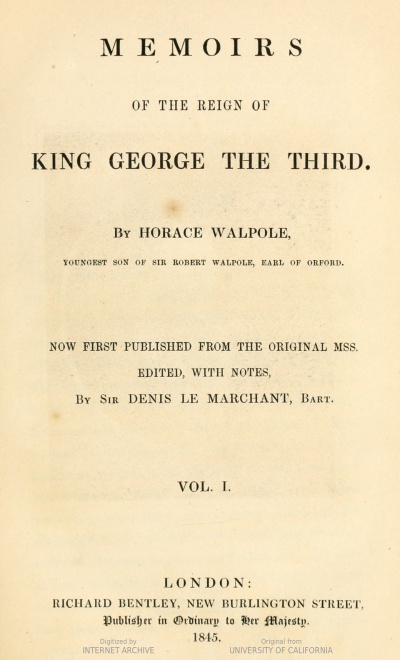
Horace Walpole. Memoirs of the Reign of King George the Third ... Edited, with notes, by Sir D. Le Marchant. Horace Walpole. London, 1845.
These Memoirs were published in 4 volumes. The listing in both the 1908 catalogue (under George III!) and the Knight Collection list only two volumes.
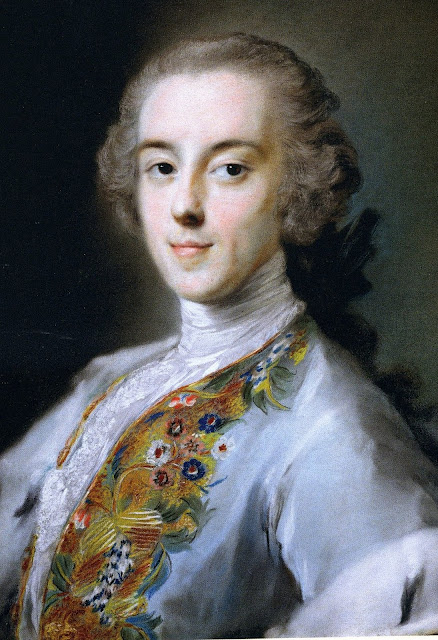
Horace Walpole (1717-1797) Horace Walpole portrait: by Rosalba Carriera, c. 1741
The Jarvis & Jones must refer to an outdoor clothing outfitter, as in Diary Vol 5, Monday February 11, 1833, Charles writes: ‘I received a velveteen shooting jacket from Jarvis & Jones.” Charles was an avid outdoorsman, not something all that clear in these posts about his (mostly) religious reading. If you want to know more about the importance of proper shooting attire and the “velveteen shooting jacket,” here is all you need to know via the The Sportsman from 1859.
****************
‘Monday Feby 9 ... I wrote to Mrs Lefroy & sent her a book by Edwd to B Stoke, who went to meet the express train. It was a manuscript of Aunt Janes from FCK.’
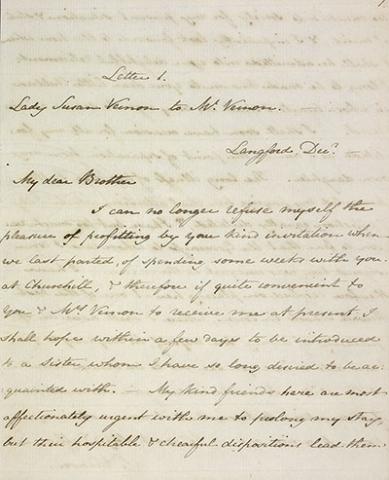
‘Lady Susan’ Manuscript – Morgan Library
Well, this is VERY exciting! Charles is writing this in February 1846. It is believed this was the manuscript of Lady Susan – Cassandra Austen had bequeathed it to her niece Fanny Knight Knatchbull on her death in March 1845 – so here it is being delivered to Mrs. Lefroy, who would be his cousin Anna Lefroy (daughter of James Austen) – exciting indeed!
*********
Tuesday Feby 19 … Went to the book sale at Wigram’s … I bought some books for myself, and some for Edwd.’
‘Saturday Feby 28 … I sent a box of books to Bain to be bound.’ (They are returned to him on April 17th.)
So I find this: the bookbinder Bain might be this – still in existence!:

Bell & Bain, founded on 4th April 1831 by James Bell and Andrew Bain, is one of the oldest established printing companies still in existence in UK. In 1891, the firm was made a limited company, under the title Bell & Bain Ltd.
I had no luck with Wigram’s as a bookseller or publisher … unless he is referring to Joseph C. Wigram, mentioned above – Wigram was the Archdeacon of Winchester and Bishop of Rochester and wrote on religious topics including a work on the management of Sunday Schools. In August 1845 (see above) Charles writes of dining at Wigrams and meeting some Heathcotes – Deirdre Le Faye includes both in her biographical index to the Letters – so could this just be a reference to a friend selling some of their books?
*********
‘Monday May 18 ... I finished the Crescent & the cross.’
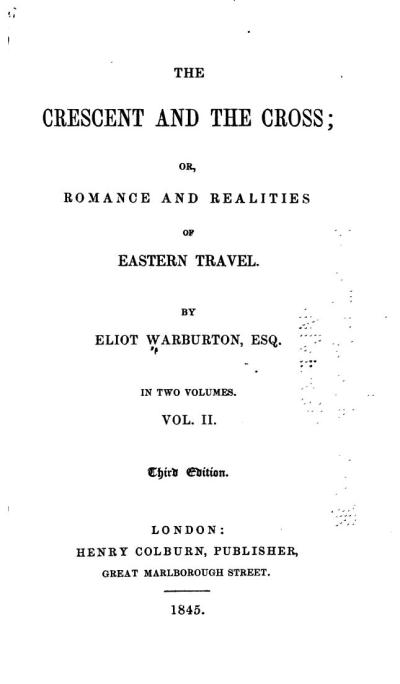
Eliot Warburton. The Crescent and the Cross, Or, Romance and Realities of Eastern Travel. London: Henry Colburn, 1845.
Warburton, was an Irish traveler and novelist, born near Tullamore, Ireland. This book was an account of his travels in 1843 in Greece, Turkey, Syria, Palestine and Egypt – I mentioned above the Kinglake book Eothen – they appeared at nearly the same time and shows the public’s ongoing interest in such travels. The fact that Charles read both accounts is telling. Warburton’s book was a huge success and went into 18 editions! It is however, neither in the 1908 nor the Knight Collection.
And just to give another nod to Horace Walpole, Warburton wrote the Memoirs of Horace Walpole and His Contemporaries (London: Colburn, 1852).
****************
1847: ‘April 22 … read Roscoe’s life of Lorenzo de ‘ Medici & got thro’ the preface & part of the 1st chapter.’
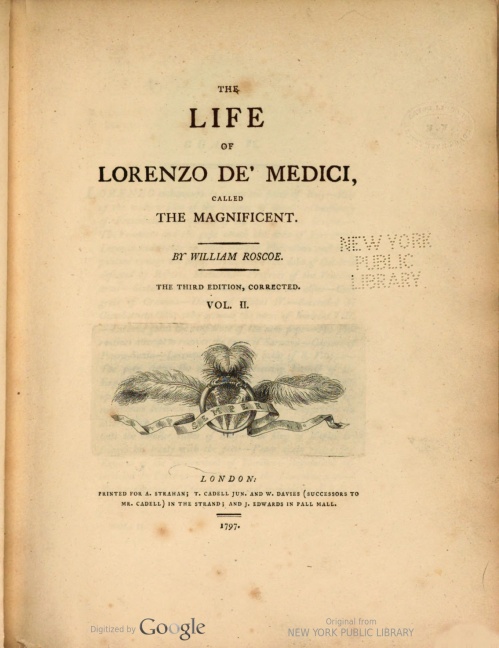
Roscoe – Title page, Vol 2 of 3rd ed, 1797 – HathiTrust
William Roscoe. The Life of Lorenzo de’ Medici called the magnificent. I-II. London: Printed by J. M’Creery and Sold by J. Edwards, 1795.
There are several editions of this work, so not sure which Charles is reading as it is not listed in either catalogue – first edition was published in 1795 in 2 volumes.
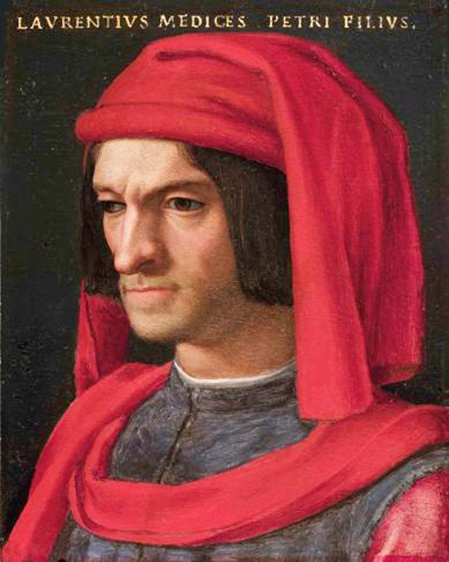 Portrait of Lorenzo de’ Medici, 15th century,
Portrait of Lorenzo de’ Medici, 15th century,
Agnolo Bronzino and workshop (Wikipedia)
************************
‘Thursday May 13 … Wrote for some books to Varty.’ [Charles was a boon for the independent bookshop!]
‘June 8 … Sarah Ewens began to be educated by me today as candidate for a pupil teacher; we began Mrs Markham’s History of England.’
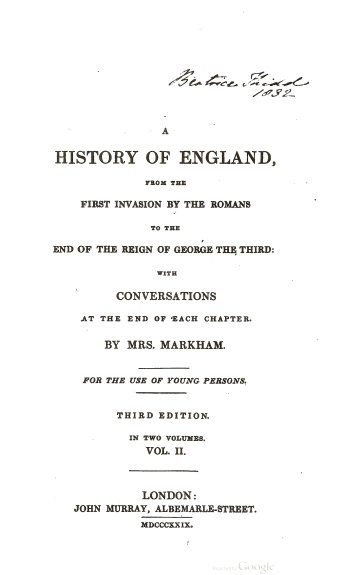
Mrs. Markham (i.e. Elizabeth Penrose). A History of England from the First Invasion by the Romans to the End of the Reign of George III. (1823).
Elizabeth Penrose (1780 – 1837), known by her pseudonym Mrs. Markham, was an English writer, mostly of histories and stories for children. Her History of England, first published in 1823, went through many editions, with the title changing with the addition of the reigning monarchs after George III. We cannot know which edition Charles was using for teaching Sarah Ewens.
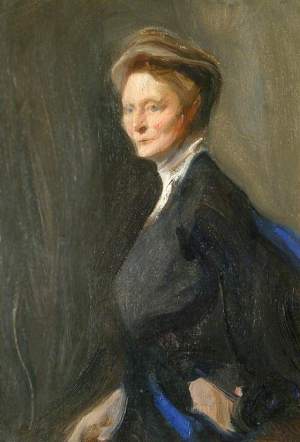
Philip de Laszlo. Sketch for ‘Dame Emily Penrose – wikipedia
[An additional bit on Penrose is that her granddaughter was Dame Emily Penrose, DBE (1858 – 1942) – she was Principal of three early women’s university colleges in the UK: Somerville College, Oxford University from 1907 until 1926, the Principal of Royal Holloway College from 1898 until 1907, and the Principal of Bedford College from 1893 until 1897.]
*****************
Diary 15: August 1st 1847 to March 24th 1851
1848: ‘Monday Oct 17 … Wrote to Varty for some stationery & books for the school.’
‘Sunday Oct 22 ... Had the pupil teachers at 5 to read Secker’s lectures.’ (And the following Sunday.)
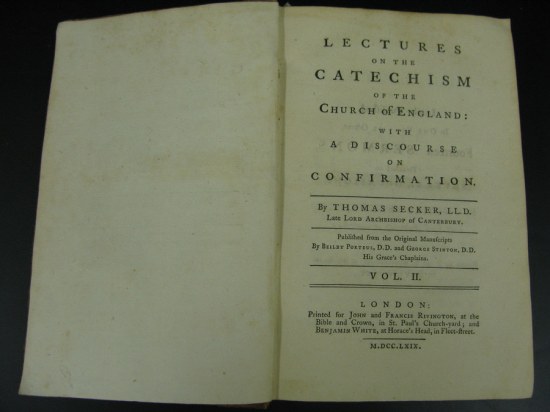
Secker Lectures – from Reading with Austen website
Thomas Secker appeared in Part IV: this was in the GPL and remains in the Knight Collection:
Lectures on the Catechism of the Church of England: with A Discourse on Confirmation. By Thomas Secker, LL.D. Late Lord Archbishop of Canterbury. Published from the Original Manuscripts By Beilby Porteus, D.D. and George Stinton, D.D. His Grace’s Chaplains. London, 1769.
**********
1849: ‘Thursday April 5 … I went to Alton & ordered Burke’s landed gentry & Williams’s laws relating to the clergy.’
There are so many editions of Burke’s landed gentry – it has its own wikipedia page!
Since he is ordering this in 1849, it might be the edition of 1843-49 titled:
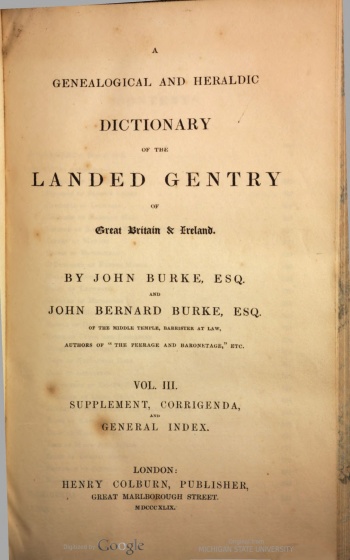
A Genealogical and Heraldic Dictionary of the Landed Gentry of Great Britain and Ireland, a companion to the Baronetage and Knightage. By John Burke and John Bernard Burke. London: H. Colburn, 1845-1848.
No editions are listed in either catalogue. The Knight Collection has only this book by Bernard Burke: Encyclopaedia of Heraldry: or General Armory [later titled General Armory, which is how it is listed in the Knight Collection – first published in 1884 under this title.]
For Williams, I find this:
David Williams. The laws relating to the clergy; being a practical guide to the clerical profession in the legal and canonical discharge of their various duties. London: Printed for Sherwood, Neely, and Jones, 1813 and a 2nd ed in 1822.
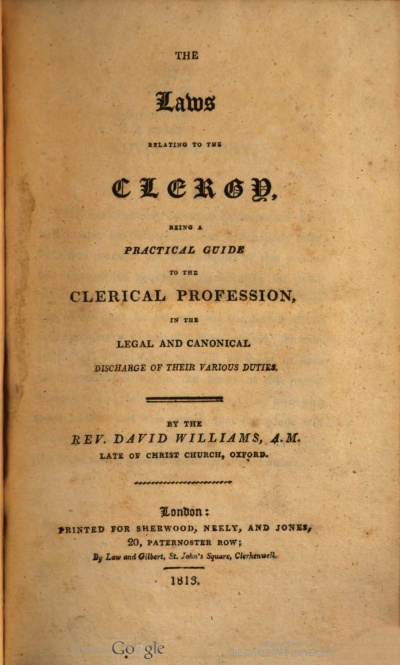
The Knight Collection has a book titled: The Duties and Rights of the Clergy – this could refer to Edward Stillingfleet’s Ecclesiastical cases relating to the duties and rights of the parochial clergy stated and resolved according to the principles of conscience and law / by the Right Reverend Father in God, Edward, Lord Bishop of Worcester. London: Printed by J.H. for Henry Mortlock.., 1698.
There are other titles by Edward Stillingfleet in the GPL catalogue, but not this one – need to have a better look at the complete title in the Knight Collection.
****************
‘April 18 … Preparations for lending Library.’ (In Alton. Charles suggested setting it up.)
‘April 19th ... arranged the lending Library books and tracts.’
‘April 22 … Gave G. Ewens some books to cover for the lending Library.’
Well, hooray for Charles! I need to research more to see if the existing library in Alton, located on Vicarage Hill, is actually the very one that Charles Knight started in the community.
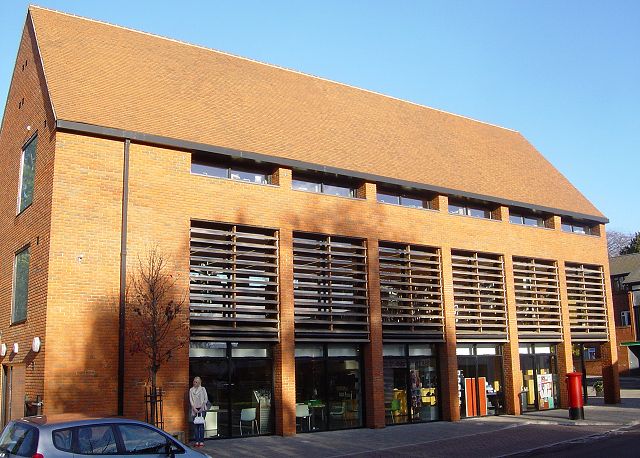
Alton Library, Vicarage Hill (Wikipedia)
*****************
1850: ‘Feb 11. Monday … Began to read “Daily steps toward Heaven.” God grant they may really lead me there.’
[I hope you are now there too Charles!]
I find this:
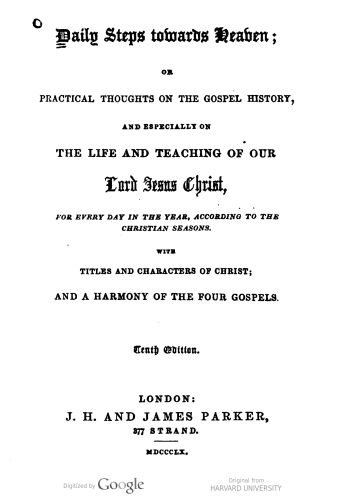
Daily steps toward Heaven, or practical thoughts on the Gospel history, and especially on the life and teaching of our Lord Jesus Christ, for every day of the year, according to the Christian seasons, with titles and characters of Christ, and a harmony of the four Gospels. London, Park, 1850. 2nd ed. By A. H. Dyke Acland, afterwards Troyte. Earliestr edition I find is 1849. This title page is from 1860.
‘July 22. Monday. Called on Mrs Hedges. Lent her Mant’s book about the state of the blessed.’
Se, there are a few options here:
The Souls of the Blessed. By Bishop Mant. London: Edwards and Hughes, 1844. Series: Tracts for Englishmen, 6; Pamphlets, v. 1, no. 26.
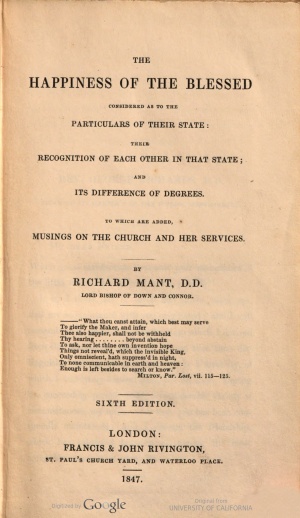
The Happiness of the Blessed considered as to the particulars of their state; their recognition of each other in that state; and its difference of degrees. … To which are added Musings on the Church and her Services [in verse]. By Richard Mant, successively Bishop of Killaloe, and of Down, Connor and Dromore. London, 1833.
[my underlines – Charles’ words are “the state of the blessed” so likely he is referring to this book]
This book is not in either catalogue or the Knight Collection.
But I like this one the best, though I don’t think even Charles could have imagined this one in 1850, because it was not published until 1869!
Henry Alford. The State of the Blessed Dead. This was one of 4 discourses delivered in Canterbury Cathedral during Advent in 1868, and appeared in the “Pulpit Analyst” in 1869.
*************
So we will leave Charles with his reading and his writing here. There are no more diaries, at least none have yet been found. Charles lived until 1867, and it would be odd that from 1851 until his death he would have stopped journaling – we can only hope more will be located.
As a final parting, here is an example of Charles’ diary writing, making our little peak into his life all the more personal, and with thanks again to Hazel for sharing this: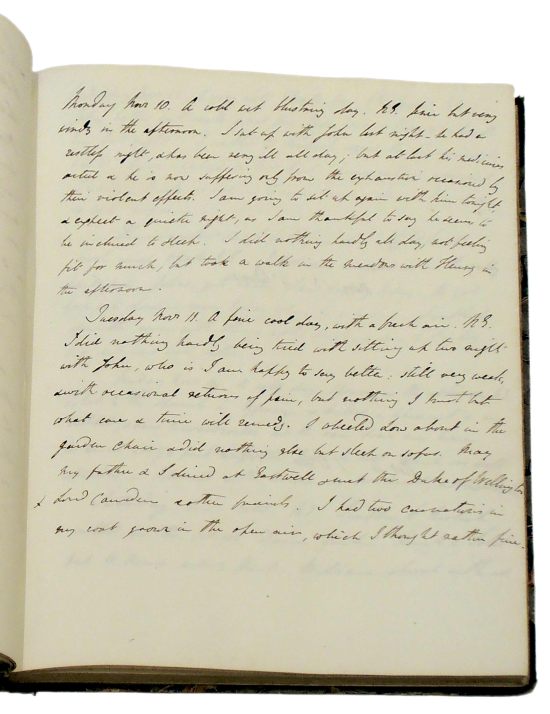
Extract from Charles Knight’s diary for 1834
**********

If you want to learn more about Charles Bridges Knight, Hazel has just published her new book The Other Knight Boys: Jane Austen’s Dispossessed Nephews (Uppercross Press, 2020). You will learn much about Charles, as well as all of his brothers: Edward, George, Henry, William, and John. It is a compelling tale of Jane Austen’s brother Edward’s male children. I have enjoyed reading along with Charles (well some of the time!) – I hope you have too. It has been a grand entry into the Godmersham Park Library and later the library at Chawton House as we continue the search for the LOST SHEEP – help us if you can!
**************
Links to the previous five posts on Charles’ diaries, with again, sincere thanks to Hazel Jones for sharing all the diary entries about Charles in the Godmersham Library.
-Charles Bridges Knight at GPL Part I
-Charles Bridges Knight at GPL Part II
-Charles Bridges Knight at GPL Part III
-Charles Bridges Knight at GPL Part IV
-Charles Bridges Knight at GPL Part V
Thank you Deb and Hazel!
Jocelyn.
From: Reading with Austen
Reply-To: Reading with Austen
Date: Wednesday, 13 May 2020 at 4:26 AM
To: Jocelyn Harris
Subject: [New post] Reading in the Godmersham Library: Jane Austen’s Nephew Charles Bridges Knight ~ Part VI
Janeite Deb posted: “So, I beg
LikeLike
Pingback: Interview with Hazel Jones, author of “The Other Knight Boys: Jane Austen’s Dispossessed Nephews” – Jane Austen in Vermont
Pingback: Jane Austen and Her French Connections – Jane Austen Society of North America – New Jersey Region